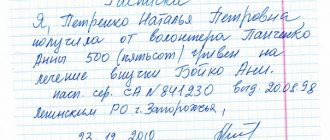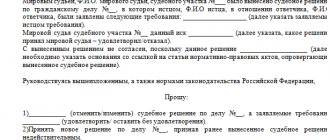The amount and type of alimony deductions are established by the courts issuing the writ of execution. And the parties choose the method of transferring and receiving alimony funds independently.
This method, such as drawing up a receipt for alimony, is used by the payer and the recipient when funds are transferred voluntarily, from hand to hand. The parties trust each other, but still they need some kind of factual confirmation of the transfer of funds. Such a receipt is a written document confirming the transfer by the payer to the recipient of funds as alimony.
When is a receipt required?
The method of transferring alimony “on receipt” is used by the parties between whom there is a voluntary agreement on payments. They were able to amicably resolve the issue of alimony, which means they are able to meet in a civilized manner to transfer money. But the spouses can also agree on this method of transferring alimony during the trial.
It is inappropriate to transfer money against receipt to a payer who works permanently at one enterprise, where the responsible accountant himself will calculate the alimony payment, deduct the amount from the salary and transfer it to the recipient. It’s another matter if the accountant is not trusted.
A receipt for alimony is kept as a guarantee of the transfer of not the main payment, but an additional one. Additional financial assistance to a child is a personal voluntary matter of the payer, but it is very important to document this fact.
Legal basis
Article 61 of the RF IC explains that parents are endowed with the same rights and responsibilities in relation to their children.
Both parents are obliged to allocate money for the maintenance of their children and take part in their upbringing.
You might be interested:
How to get child support from your father if he is not included in the birth certificate.
How to get child support for a disabled child?
Is it possible to apply for alimony for a pregnant woman during marriage and divorce?
The parent in whose care the child remains has the right to receive alimony from the second parent, both for the benefit of the child and for the benefit of himself.
The main regulations are:
- Family Code of the Russian Federation;
- Constitution of the Russian Federation;
- Federal Law No. 223;
- Federal Law No. 124 of July 24, 1998.
How to apply
A receipt for payment of alimony is issued in writing. Its name itself speaks to this.
The author of the paper has the right:
- write it in your own hand;
- print using a computer;
- produce several forms at once, in which you only need to enter the personal data of the parties.
Any method of processing the transfer of money contains certain pros and cons.
Option 1. So, it is better to write the receipt entirely by hand to the author who has sufficiently legible handwriting. An unclear text or mistakes made in it are quite easily subject to distortion of meaning. For this reason, the receipt may lose its legal force, and accordingly the fact of receiving alimony in hand will be doubtful.
But based on such a receipt, a graphological examination is carried out. Analysis of a sufficiently voluminous text can, with a high probability, identify the author of the receipt in the event of a dispute over the transfer of money.
Option 2. A printed receipt is easy to read. But: firstly, the person transferring and receiving money does not always have the opportunity to use a computer or other printed means at the moment, and secondly, only a signature is made by hand. Which is not always enough if you have to confirm the author of the receipt in court.
The payer and recipient agree on how to write a receipt for alimony.
Option 3. It is most convenient to prepare a printed form with empty columns for entering personal data in your own hand (passport number, amount of money transferred, date and signature).
The advantages are obvious:
- no need to constantly have a computer and printer nearby;
- you don’t have to write all the text by hand;
- combined text is easier to perceive;
- In case of a dispute, handwritten text will be quite sufficient to conduct graphology.
Let's sum it up
When transferring alimony payments, it is recommended to draw up a receipt in 2 copies - for the alimony payer and the recipient of the funds. Having a receipt prevents many controversial issues and litigation in the future.
There are several options for drawing up a receipt: written, printed or ready-made form. The last option is optimal: a person does not need to handwrite the text of a document every month, and if necessary, a handwriting examination can be carried out.
The receipt will need to include information about the parties to the procedure, the amount of alimony, and the minor. The recipient of the funds indicates that he has no claims regarding the amount of payments.
The receipt should be certified by an employee of a notary agency if a large financial sum is being transferred. When transferring regular monthly payments in the established amount, there is no need to certify the document or use the help of witnesses.
Do I need a notary or witnesses?
It is a mistaken belief that when transferring and receiving funds for alimony, a notary or, at a minimum, witnesses must be present. Their signatures on the receipt are not required.
But the law does not prohibit the involvement of third parties to confirm the fact of transfer of money against receipt. This is solely at the discretion of the parties.
You just need to keep in mind: if someone else is indicated in the text of the receipt, then his signature is desirable. If a dispute arises in court, he will be able to play the role of a witness to the transfer of finances.
Notarized confirmation of legal force will not add to this document, but can only influence the subjective opinion of the judge in the event of a trial. More often, such a “safety net” is used by a party that is not confident in its opponent and wants to additionally record the fact of a money transfer.
Legal force
This concept in the scientific literature is understood as the ability of a document to bear legal consequences and be the subject of legal actions. The main condition for a receipt to have legal force is its correct drafting.
Russian legislation does not require it to be notarized. It has legal force if all mandatory requirements are met, and will be valid when presented to judicial or other government authorities.
It is sufficient to comply with all the necessary conditions, which include the correct reflection of complete and reliable information about the participants in the legal relationship.
Note! If the child’s father has decided to pay a child support debt or, say, a large sum towards his obligation in advance, then it is recommended to notarize this fact.
As mentioned above, if one of the parties wants to collect alimony debt, the presence of a correctly executed receipt will confirm the payments made to the recipient.
What to write
A receipt for child support is drawn up arbitrarily. But there are points that must be reflected in it:
- Last name, first name, patronymic of the alimony payer, full details of his passport, addresses where he is registered and where he actually resides.
- The same data relating to the recipient of alimony.
- The reason why the money is transferred (as payment of alimony, to pay off alimony debt). You can make a link to the document on the basis of which the payment is made (agreement, writ of execution).
- Last name, first name, patronymic and date of birth of the child to whom the alimony payment is transferred.
- Amount of cash transfer. It is correct to write it first in numerical terms, and then in parentheses in words. They must coincide, otherwise what is written in words will be taken as true.
- The alimony period for which the payment is made (for October 2021, for the period from March 1 to October 31, 2021, towards the alimony debt for 2020).
- Date and place of compilation.
- Signature of the alimony recipient or both parties, third parties involved, if any.
Breach of trust
In life, good relations between people are not always maintained after the termination of marriage.
Often contacts between ex-husband and wife are hostile. This is confirmed by examples of divorces of public figures and representatives of show business.
Based on the desire to “spoil” the ex-wife, in the future there may be a desire to review, challenge or additionally collect the alimony debt through the court.
In such a situation, the plaintiff will not always act decently towards his opponent.
Inflicted grievances, and sometimes the division of property, during a previous family life together, often outweigh common sense and push the commission of such actions.
Most often, going to court to obtain a penalty for alimony when monthly payments are made is a woman’s reaction in order to take revenge on her ex-husband for the grievances caused.
Expert commentary
Roslyakov Oleg Vladimirovich
Lawyer, specialization civil law. More than 19 years of experience.
Ask a question
From a legal point of view, it is unlawful to file for collection if payments have been made in full. Another thing is when child support is not paid by a man at all, or not in full - then the woman has the right to obtain it through the court.
Possible consequences
The simplest method, which would provide grounds for review or collection of additional (often illegal) payments, is to appeal to the judicial authorities regarding non-payment of alimony.
However, you should expect to win the case in court only if the money was transferred from hand to hand without selecting a document certifying the completion of this action.
If there is no supporting written evidence, then the ex-wife, by filing a claim in court, has a chance to oblige the child’s father to pay a penalty for alimony that was actually received earlier.
We recommend! How to receive alimony for a wife on maternity leave: conditions for collecting alimony for the maintenance of a disabled spouse during marriage and after its dissolution
However, no matter what arguments are given by the defendant, the main argument confirming the actions taken will be a receipt for the transfer of funds. If it is not there, the court can most often support the plaintiff’s arguments.
If the ex-husband has not fulfilled (or partially fulfilled) his alimony obligations, i.e., has evaded paying them, in this case it is necessary to go to court to collect a penalty by filing a statement of claim.
You can draw it up by contacting a lawyer through the form on the website, where there are samples of claims for this type of court case
Examples of receipts for receiving alimony money
Example 1: Simplified handwritten form
Receipt
I, Svetlana Nikolaevna Nikityuk, registered and residing at the address: Turgan, Enina St., 25-2, passport 00 00 No. 000000, issued by the Department of the Federal Migration Service of Russia for the Turgan Region in the city of Turgan on May 25, 2005, received from Ivan Ivanovich Nikityuk , registered and residing at the address: Turgan, Stroiteley St., 27, passport 00 00 No. 000000, issued by the Department of the Federal Migration Service of Russia for the Turgan Region in the city of Turgan on December 15, 2003, alimony in the amount of 12,500 (twelve thousand five hundred) rubles for maintenance our child Nikityuk Artem Ivanovich, born on March 15, 2013, in January 2021. I have no complaints.
Signatures: _________________ (Nikityuk S.N.) _________________ (Nikityuk I.I.) 10/05/2021
Example 2. Printed sample with a link to a document on the collection of alimony
Receipt for receipt of funds under the Agreement on the payment of alimony for a minor child, Turgan, 02/05/2021
I, Svetlana Nikolaevna Krivtsova, registered and residing at the address: Turgan, Enina St., 25-2, passport 00 00 No. 000000, issued by the Department of the Federal Migration Service of Russia for the Turgan Region in the city of Turgan on May 25, 2005, in accordance with clause 3.1 Agreement on the payment of alimony for a minor child, concluded between me and I.I. Krivtsov. 06/05/2008, received from Ivan Ivanovich Krivtsov, registered and residing at the address: Turgan, st. Stroiteley, 27, passport 00 00 No. 000000, issued by the Department of the Federal Migration Service of Russia for the Turgan region in the city of Turgan on December 15, 2003, alimony in the amount of 250,000 (one hundred fifty thousand) rubles 00 kopecks for the maintenance of the child Artem Ivanovich Krivtsov, born on March 15, 2013, for the period from January to April 2021. I have no complaints.
Signature (Krivtsova S.N.)
Signature (Krivtsov I.I.)
Text
The contents of the receipt should be written in legible handwriting, without errors; corrections and crossing out are also not allowed. If they are entered, then the signatures of the alimony payer and the recipient must be left next to them as identification.
The text can also be printed and signed, but in this case the interested party may lose the opportunity to challenge the validity of the document.
If money is provided for material support, then the receipt does not have to indicate that it will be used to pay alimony. The exception is when they are used to cover additional expenses, for example, for treatment or education of a child upon reaching the agreement of the parties in the second case. This condition is provided in order not to bring the child into a difficult financial situation in the event of difficult life circumstances for the other party in the family relationship.
It is also possible to supplement the document with the phrase that the parties have no claims regarding fulfilled obligations and the amount of payment. This mark is important primarily for the payer of the funds.






